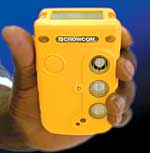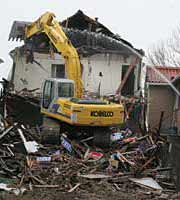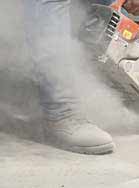Where are the safety professionals of tomorrow coming from, and will they be needed?

"We constantly refresh our pool of ideas. Our end users are very vocal about what works and doesn't work."
More than a million U.S. workers are exposed to potentially harmful vibrations from the tools they use at work, says Joseph D. McGarry, president of Gloves-Online.com.

Will the safety and health community respond to a sincere invitation to ensure these important tools are maintained? FOHS President Dean Lillquist, Ph.D., CIH, and American Conference of Governmental Industrial Hygienists (ACGIH®) board Chair Larry Gibbs, MEd, MPH, CIH, discussed the new fund Dec. 11, 2008, a week after FOHS announced it. This Q&A is the result.
AEDs are much improved since they began showing up in airports, arenas, and workplaces. Training is an essential part of getting workers to use them when necessary, and that training performs a valuable service in accurately educating the trainees about the latest guidelines for performing CPR, said Pam Erno, national account manager for the Health & Safety Institute.

Office Depot recently conducted a survey that found 71 percent of businesses do not have a disaster plan in place. Federal data indicate more than 40 percent of businesses never reopen after a disaster affects them, according to the company. Because 80 percent of its customer base is small to medium-sized businesses, Office Depot considers it important to help them protect their businesses, said Tom Serio, Director of Global Business Continuity Management for the company, which has 52,000 associates and about 1,500 stores worldwide.

You may not realize that a worker's shoes make him or her more productive, but Tom Votel makes a good case below for the proposition. And if good footwear and inserts can boost productivity, it stands to reason that poor footwear can harm it. Votel, President and CEO of Ergodyne discussed footwear's role in worker productivity during an April 13, 2007, conversation with Occupational Health & Safety's editor. Excerpts from the conversation follow.
Why are heat and humidity such a threat to certain workers, such as those who work outdoors or in foundries?
Are some trainers/companies thinking the new guidelines have discredited on-scene defibrillation or made it less important?
Safety in U.S. coal mines has been a front-burner issue since a methane explosion killed 12 miners Jan. 2, 2006, inside the Sago Mine, located near Buckhannon in Upshur County, W.Va. That incident sparked the MINER Act, an important reform of federal mine safety regulations; a 101-page report delivered in July 2006 to West Virginia Gov. Joe Manchin III; and an independent, 10-member commission of experts created by the National Mining Association to examine mine safety technology and training.
Editor's note: Safety and hazmat professionals can be and should be major contributors to overall emergency preparedness, says Steve Laughlin, CHMM, of CJ&K Training Services in Lindenhurst, Ill. Laughlin, who coordinates Emergency Response Scenarios at annual conferences of the Academy of Certified Hazardous Materials Managers, Inc., believes such events alert the response community to safety professionals' skills and knowledge.
Editor's note: End users' confusion about multiple classes of protective apparel will ease as they become familiar with new editions of NFPA standards for responders' protective apparel, says Jeffrey O. Stull, president of International Personnel Protection Inc. of Austin, Texas.
Editor's note: The promise of AEDs has not been fully realized for several reasons, most notably our failure to train potential users in a way that truly prepares them for the experience, contends Frank J. Poliafico, RN, director of the Initial Life Support Foundation (www.ilsf.info, 610-566-2824) of Media, Pa.
Editor's note: Changing the way employees' hours were scheduled and providing recognition for their efforts have been successful strategies for Virginia Blood Services (www.vablood.org) of Richmond, Va., says VBS Vice President of Organizational Development Eleanor Boens. The independent, non-profit organization serves the state's two largest hospitals and many other hospitals in Virginia.
Editor's note: Don't overlook the message you send to employees by deploying automated external defibrillators. They can be a powerful symbol of a company's commitment to its workforce and its culture, as Teradyne Inc.'s Loren Eaton, vice president of human resources, and Andy Porter, manager of corporate communications, pointed out in a Feb. 9, 2006, conversation with Occupational Health & Safety's editor. Excerpts from the conversation follow.
Editor's note: The U.S. chemical industry deserves praise for taking care of its own security by spending millions of dollars to harden plants' perimeters, says Jerry Blackman, Honeywell's Global Director of Industrial Security Solutions. Honeywell Security's products for industrial customers (call 602-313-4712 for information) include video recorders, cameras, perimeter control and lobby access systems, intrusion sensors, control panels, and wireless fire and burglary alarm systems.
Editor's note: Some ideas are so smart that you wish you'd thought of them yourself. Reused protective footwear, for example. If you haven't considered the possibility until now, Wayne Elsey, president of Kodiak-Terra USA, Inc. (www.kodiakterra.com) of Portland, Tenn., may make you a believer.
Editor's note: Broad changes in the U.S. manufacturing sector and within the safety industry have made it more difficult to sell prescription safety glasses to employees, who collectively pay an increasing percentage of the glasses' cost, say Titmus Optical, Inc.'s Mike Franz, senior marketing/product manager, protective products, and Joe Parsons, director of sales.
Editor's note: The "next stage" of AEDs promises to combine CPR and automated external defibrillation in a new, user-friendly way, says Jamie Froman, director of marketing for the commercial AED business of Philips Medical Systems (www.philips.com). Froman, who works in the company's Seattle, Wash., offices, discussed recent developments in AEDs and CPR on Nov. 22, 2005, with Occupational Health & Safety's editor. Excerpts from the conversation follow: